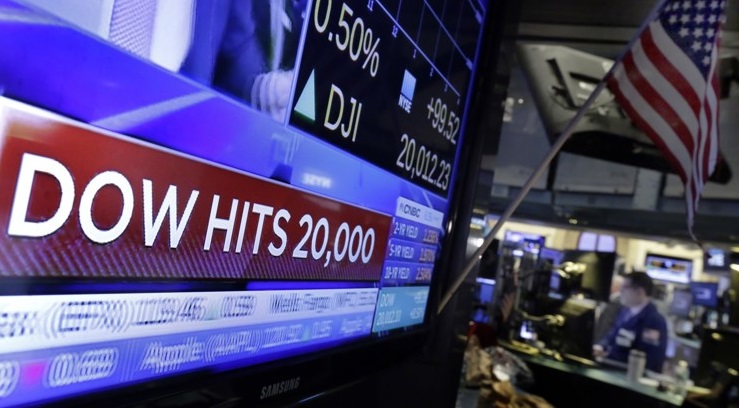Is The Dow 20’000 So Meaningful?

Whenever the Dow Jones Industrial Average reaches a new milestone the investors are used to cheer. It happened last week, when the most famous of the stock indexes broke the 20’000 mark, after flirting with this significant level for about two months. Is this new record so important for the market? To be honest, it looks difficult to find a rational reason for all this excitement, 20’000 is just a number, as they were all the round numbers that the index had reached in the past years. Psychology is important at this matter: a close above 20’000 feeds optimism and confidence, especially among retail investors, and translates into new purchases.
It’s well known, especially among professionals, that the Dow Jones industrial average has lost its charm as market barometer. Just a few stocks in a universe of thousands, other benchmark has replaced it since a long ago, especially the Standard & Poor’s 500. Why then, a break above 2000 or 2300 for the S&P, howsoever well noted by the specialist, is not celebrated the same way? For sure, there is an important romantic aspect. The Dow Jones Industrial Average, now 120 years old, wrote the history of Wall Street. The index contains 30 largely owned and traded U.S. companies, initially they were only 12, in 1928 the number was increased to 30, only one member, General Electric, still belongs since 1896. The adjective industrial that is part of the name, has little to do with the common definition of this economic sector. The average is price-weighted, and not capitalization-weighted like most market benchmarks. It does not mean that the prices of its constituents are averaged but rather summed and then divided by a divisor which changes when a component has a stock split or dividend, or is replaced by another member. It may sound naïve but this method avoids the typical disparities of other popular indexes, mostly European, that are heavily influenced by the swings of a few companies.
Figure 1: Dow Jones Industrial Average – Monthly data 1952 to date. The red lines depict the most significant milestones starting from 1’000.
The elders among us remind when people wondered if we would ever get through Dow 1,000. It touched that level in 1965 but failed to close above, then retreated 25% in the following year. The first close above 1000 was in 1972, then a further impulse of about 5% formed a major top from which a severe bear market began (-45%). It took ten years of exhausting swings before the start of the legendary bull market of the 1980s.
Figure 2: Dow Jones Industrial Average – Daily data 1965-1983. It was not an easy way above the 1’000 mark (red line).
But not all the milestones overcoming had been so wearing. The break of 2000 marked the end of a pause during a sharp bull market and pushed towards the 1987 top around 2750, in August, before the crash. Don’t forget that the higher it goes the easier it is to gain 1000 points (1’000 to 2’000 equals 100%, just 10% from 10’000 to 11’000), then it sounds meaningless to give importance to moves lesser than 5/10’000 points at today’s levels. When the Dow got through 10’000, in April 1999, there was a lot of optimism, the valuations were stretched, it run above 11’000 before a congestion that lasted several months.
Figure 3: The way between 2’000 and 10’000 – Dow Jones Industrial Average – Daily data 1984-2002. The breaks occurred among quite different environments.
And now? First, we should consider that all the past occurrences described above happened in quite different environments, not only in terms of technical patterns. So, we can conclude that the markets behavior has little to do with the round figures reached by this or that index, excepted the psychological factor that may influence short living moves.
Figure 4: Dow Jones Industrial Average – Daily data, December 2015 to date. The recent move above 20’000 breaks off the narrow trading range of the last two months (19700/20000).
The recent close above 20’000 breaks off the narrow trading range of the last two months (19700/20000). In technical analysis, this is usually considered as a continuation pattern, on the upside in this case, since the former move was up, which target at short term is around 20’300. The retreat below 20’000 can be considered as a pullback retesting the former resistance but does not deny the bullish signal of last week, unless a break below 19’000 reveals a trap in the recent breakout.
A larger view (7 years in figure 5) shows the persistence of a bullish channel, although stretched on the upside, with a still positive momentum. The real bullish signal was that of last summer, above 18’000, that concluded a continuation pattern which target is around 20’500. Even in such a bullish environment, a further move on the upside could well take to a seasonal top in the next few weeks, not very far from here, from which start a new distribution as a cleanup of the excesses reached by the medium-long term indicators.
Figure 5: Dow Jones Industrial Average – Weekly data, 2010 to date.
Alberto VIVANTI – SAMT Vice President – Graubünden and Liechtenstein Chapter– alberto.vivanti@samt-org.ch
Disclaimer: the above article is for general information and educational purposes only. It is not intended to be investment advice. Seek a duly licensed professional for investment advice.

